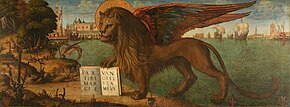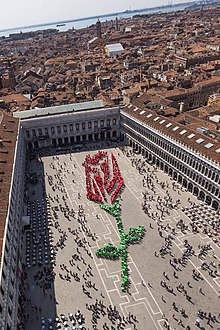

|
Mark the Evangelist
| |
|---|---|

Detail from a window in the parish church of SS Mary and Lambert, Stonham Aspal, Suffolk, with stained glass representing St Mark the Evangelist
| |
| Evangelist, Martyr | |
| Born | c. 12 AD Cyrene, Crete and Cyrenaica, Roman Empire (according to Coptic tradition)[1] |
| Died | c. 68 AD (aged c. 56) Alexandria, Egypt, Roman Empire |
| Venerated in | All Christian churches that venerate saints |
| Major shrine |
|
| Feast |
|
| Patronage | Barristers, Venice,[2] Egypt, Copts,[3] Mainar, Podgorica[4] Pangil, Laguna |
| Major works | Gospel of Mark (attributed) |
Mark the Evangelist[a] (Koinē Greek: Μᾶρκος, romanized: Mârkos) also known as John Mark (Koinē Greek: Ἰωάννης Μάρκος, romanized: Iōannēs Mârkos; Aramaic: ܝܘܚܢܢ, romanized: Yōḥannān) or Saint Mark, is the person who is traditionally ascribed to be the author of the Gospel of Mark. Modern Bible scholars have concluded that the Gospel of Mark was written by an anonymous author rather than an identifiable historical figure. According to Church tradition, Mark founded the episcopal seeofAlexandria, which was one of the five most important seesofearly Christianity. His feast day is celebrated on April 25, and his symbol is the winged lion.[5]

According to William Lane (1974), an "unbroken tradition" identifies Mark the Evangelist with John Mark,[6] and John Mark as the cousin of Barnabas.[7] However, Hippolytus of Rome, in On the Seventy Apostles, distinguishes Mark the Evangelist (2 Timothy 4:11),[8] John Mark (Acts 12:12, 25; 13:5, 13; 15:37),[9] and Mark the cousin of Barnabas (Colossians 4:10;[10] Philemon 1:24).[11][12] According to Hippolytus, they all belonged to the "Seventy Disciples" who were sent out by Jesus to disseminate the gospel (Luke 10:1ff.)[13]inJudea.
According to Eusebius of Caesarea,[14] Herod Agrippa I, in his first year of reign over the whole of Judea (AD 41), killed James, son of Zebedee and arrested Peter, planning to kill him after the Passover. Peter was saved miraculously by angels, and escaped out of the realm of Herod (Acts 12:1–19).[15] Peter went to Antioch, then through Asia Minor (visiting the churches in Pontus, Galatia, Cappadocia, Asia, and Bithynia, as mentioned in 1 Peter 1:1),[16] and arrived in Rome in the second year of Emperor Claudius (AD 42).[17] Somewhere on the way, Peter encountered Mark and took him as travel companion and interpreter. Mark the Evangelist wrote down the sermons of Peter, thus composing the Gospel according to Mark,[18] before he left for Alexandria in the third year of Claudius (AD 43).[19]
According to the Acts 15:39,[20] Mark went to Cyprus with Barnabas after the Council of Jerusalem.
According to tradition, in AD 49, about 16 years after the Ascension of Jesus, Mark travelled to Alexandria and founded the Church of Alexandria, having already been in Egypt for 4-5 years. The Coptic Orthodox Church, the Greek Orthodox Church of Alexandria, and the Coptic Catholic Church all trace their origins to this original community.[21] Aspects of the Coptic liturgy can be traced back to Mark himself.[22] He became the first bishop of Alexandria and he is honoured as the founder of Christianity in Africa.[23]
According to Eusebius,[24] Mark was succeeded by Anianus as the bishop of Alexandria in the eighth year of Nero (62/63), probably, but not definitely, due to his coming death. Later Coptic tradition says that he was martyred in 68.[1][25][26][27][11]
Modern Bible scholars (i.e. most critical scholars) have concluded that the Gospel of Mark was written by an anonymous author rather than by Mark.[28][29][30][31] For instance, the author of the Gospel of Mark knew very little about the geography of Palestine (having apparently never visited it),[32][33][34][35] "was very far from being a peasant or a fisherman",[32] was unacquainted with Jewish customs (unlikely for someone from Palestine),[34][35] and was probably "a Hellenized Jew who lived outside of Palestine".[36] Mitchell Reddish does concede that the name of the author might have been Mark (making the gospel possibly homonymous), but the identity of this Mark is unknown.[35] Similarly, "Francis Moloney suggests the author was someone named Mark, though maybe not any of the Marks mentioned in the New Testament".[37] The Routledge Encyclopedia of the Historical Jesus takes the same approach: the author was named Mark, but scholars are undecided who this Mark was.[34]
The four canonical gospels are anonymous and most researchers agree that none of them was written by eyewitnesses.[38][39][40][41]
Evidence for Mark the Evangelist's authorship of the Gospel of Mark that bears his name originates with Papias (c. 60 – c. 130 AD).[42][43][44] Scholars of the Trinity Evangelical Divinity School are "almost certain" that Papias is referencing John Mark.[45] Modern mainstream Bible scholars find Papias's information difficult to interpret.[46]
The Coptic Church accords with identifying Mark the Evangelist with John Mark, as well as that he was one of the Seventy Disciples sent out by Jesus (Luke 10:1),[13]asHippolytus confirmed.[47] Coptic tradition also holds that Mark the Evangelist hosted the disciples in his house after Jesus's death, that the resurrected Jesus came to Mark's house (John 20), and that the Holy Spirit descended on the disciples at Pentecost in the same house.[47] Furthermore, Mark is also believed to have been among the servants at the Marriage at Cana who poured out the water that Jesus turned to wine (John 2:1–11).[48][47]
According to the Coptic tradition, Mark was born in Cyrene, a city in the Pentapolis of North Africa (now Libya). This tradition adds that Mark returned to Pentapolis later in life, after being sent by PaultoColossae (Colossians 4:10;[10] Philemon 24.)[49] Some, however, think these actually refer to Mark the Cousin of Barnabas), and serving with him in Rome (2 Timothy 4:11);[8] from Pentapolis he made his way to Alexandria.[50][51] When Mark returned to Alexandria, the pagans of the city resented his efforts to turn the Alexandrians away from the worship of their traditional gods.[52] In AD 68, they placed a rope around his neck and dragged him through the streets until he was dead.[52]

The Feast of St Mark is observed on April 25 by the Catholic and Eastern Orthodox Churches. For those Churches still using the Julian calendar, April 25 according to it aligns with May 8 on the Gregorian calendar until the year 2099. The Coptic Orthodox Church observes the Feast of St Mark on Parmouti 30 according to the Coptic calendar which always aligns with April 25 on the Julian calendar or May 8 on the Gregorian calendar.
Where John Mark is distinguished from Mark the Evangelist, John Mark is celebrated on September 27 (as in the Roman Martyrology) and Mark the Evangelist on April 25.
Mark is remembered in the Church of England and in much of the Anglican Communion, with a Festivalon25 April.[53]
This section needs additional citations for verification. Please help improve this articlebyadding citations to reliable sources in this section. Unsourced material may be challenged and removed.
Find sources: "Mark the Evangelist" – news · newspapers · books · scholar · JSTOR (April 2018) (Learn how and when to remove this message) |
Mark the Evangelist is most often depicted writing or holding his gospel.[54] In Christian tradition, Mark the Evangelist is symbolized by a winged lion.[55]
Mark the Evangelist attributes are the lion in the desert; he can be depicted as a bishop on a throne decorated with lions; as a man helping Venetian sailors. He is often depicted holding a book with pax tibi Marce written on it or holding a palm and book. Other depictions of Mark show him as a man with a book or scroll, accompanied by a winged lion. The lion might also be associated with Jesus' Resurrection because lions were believed to sleep with open eyes, thus a comparison with Christ in his tomb, and Christ as king.
Mark the Evangelist can be depicted as a man with a halter around his neck and as rescuing Christian slaves from Saracens.
St. Mark is the patron saint of the Copts.
Proto-orthodox Christians of the second century, some decades after most of the New Testament books had been written, claimed that their favorite Gospels had been penned by two of Jesus' disciples—Matthew, the tax collector, and John, the beloved disciple—and by two friends of the apostles—Mark, the secretary of Peter, and Luke, the travelling companion of Paul. Scholars today, however, find it difficult to accept this tradition for several reasons.
10. Just as historical critical scholars deny the Mosaic authorship of the Pentateuch, so they also deny the authorship of the four Gospels by Matthew, Mark, Luke, and John. [...] But today, these persons are not thought to have been the actual authors.
Most scholars today have abandoned these identifications,11 and recognize that the books were written by otherwise unknown but relatively well-educated Greek-speaking (and writing) Christians during the second half of the first century.
We must candidly acknowledge that all three of the Synoptic Gospels are anonymous documents. None of the three gains any importance by association with those traditional figures out of the life of the early church. Neither do they lose anything in importance by being recognized to be anonymous. Throughout this book the traditional names are used to refer to the authors of the first three Gospels, but we shall do so simply as a device of convenience.
5. The geography of Gospel Palestine, like the geography of Old Testament Palestine, is symbolic rather than actual. It is not clear whether any of the evangelists had ever been there.
Mark's knowledge even of Palestine's geography is likewise defective. [...] Kümmel (1975, p. 97) writes of Mark's "numerous geographical errors"
Like the other synoptics, Mark's Gospel is anonymous. Whether it was originally so is, however, difficult to know. Nevertheless, we can be fairly certain that it was written by someone named Mark. [...] The difficulty is ascertaining the identity of Mark. Scholars debate [...] or another person simply named Mark who was not native to Palestine. Many scholars have opted for the latter option due to the Gospel's lack of understanding of Jewish laws (1:40–45; 2:23–28; 7:1–23), incorrect Palestinian geography (5:1–2, 12–13; 7:31), and concern for Gentiles (7:24–28:10) (e.g. Marcus 1999: 17–21)
suggest that the evangelist was a Hellenized Jew who lived outside of Palestine.
Francis Moloney suggests the author was someone named Mark, though maybe not any of the Marks mentioned in the New Testament (Moloney, 11-12).
The historical narratives, the Gospels and Acts, are anonymous, the attributions to Matthew, Mark, Luke, and John being first reported in the mid-second century by Irenaeus
Finally it is important to realize that none of the four gospels originally included an attribution to an author. All were anonymous, and it is only from the fragmentary and enigmatic and—according to Eusebius, from whom we derive the quotation—unreliable evidence of Papias in 120/130 CE that we can begin to piece together any external evidence about the names of their authors and their compilers. This evidence is so difficult to interpret that most modern scholars form their opinions from the content of the gospels themselves, and only then appeal selectively to the external evidence for confirmation of their findings.
St. Mark iconography.
| Titles of the Great Christian Church | ||
|---|---|---|
| New creation | Pope and Patriarch of Alexandria 43–68 |
Succeeded by |
|
| |
|---|---|
| Bible chapters (New Testament) |
|
| Events |
|
| Phrases |
|
| People |
|
| Places |
|
| Related |
|
| In music |
|
| Manuscripts |
|
| Sources |
|
Links to related articles
| ||||||||||||||||||||||||||||||||||||||||||||||||||||||||||||||||||||||||||||||||||||||
|---|---|---|---|---|---|---|---|---|---|---|---|---|---|---|---|---|---|---|---|---|---|---|---|---|---|---|---|---|---|---|---|---|---|---|---|---|---|---|---|---|---|---|---|---|---|---|---|---|---|---|---|---|---|---|---|---|---|---|---|---|---|---|---|---|---|---|---|---|---|---|---|---|---|---|---|---|---|---|---|---|---|---|---|---|---|---|
| ||||||||||||||||||||||||||||||||||||||||||||||||||||||||||||||||||||||||||||||||||||||
| International |
|
|---|---|
| National |
|
| People |
|
| Other |
|